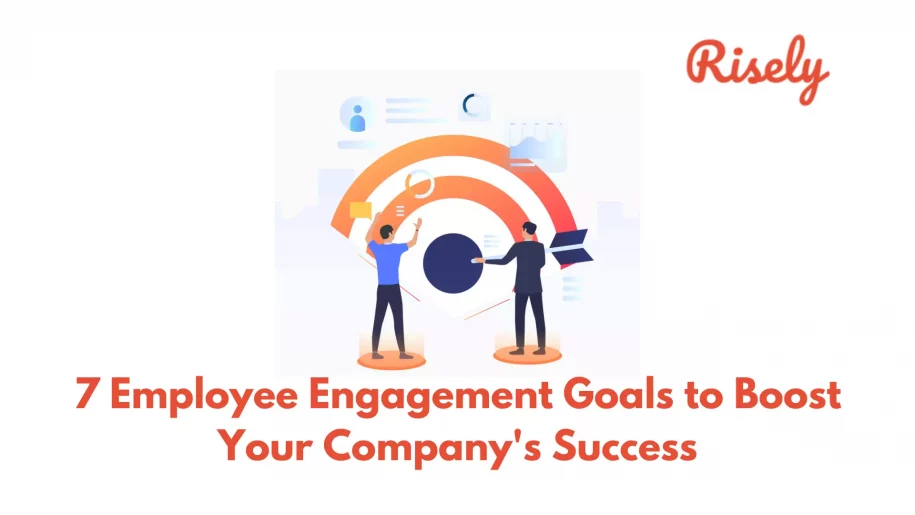7 Employee Engagement Goals to Boost Your Company’s Success
Have you ever noticed how some employees show up to work daily with purpose and enthusiasm while others go through the motions? The difference lies in employee engagement, or employees’ commitment and motivation toward their work and the organization. Engaged employees are more productive, satisfied, and less likely to leave their jobs. As a result, many organizations set employee engagement goals to improve overall performance and retain top talent. But what does it take to create a workplace engagement culture? In this blog, we’ll explore the importance of setting smart employee engagement goals and offer tips on achieving them. So let’s delve into the world of employee engagement.What is Employee Engagement?
Employee engagement refers to employees’ commitment and involvement toward their work and the organization. It involves creating a work environment where employees feel valued, supported, and motivated to perform at their best. Engaged employees are more productive, innovative, and loyal to their organization. Encouraging employee engagement is essential for companies to thrive. Measuring and improving employee engagement helps organizations create a positive workplace culture that attracts top talent and improves business outcomes.Why are Employee Engagement Goals important for Company’s Success
The importance of employee engagement goals regarding a company’s success cannot be overstated. Engaged employees are more productive, committed, and loyal to the organization, leading to better financial outcomes. Additionally, an engaged workforce can improve customer satisfaction and retention rates, making it crucial for companies to invest in employee engagement. Employers create a positive work environment that attracts top talent and drives business success by prioritizing employee well-being, implementing incentives and rewards programs, and providing professional development opportunities.How to SMART set employee engagement goals?
- Be specific: Set specific and clearly defined employee engagement goals.
- Make them measurable: Ensure the goals can be measured using specific metrics or indicators.
- Keep them achievable: Set realistic goals that can be accomplished within a reasonable timeframe.
- Ensure they are relevant: Ensure the goals align with the organization’s business objectives.
- Make them time-bound: Set a specific deadline for achieving the goals.
- Involve employees: Involve employees in the goal-setting process to promote ownership and commitment.
- Regularly monitor progress: Regularly track progress towards the goals and adjust as needed.
Track Goals Easily with Risely’s free SMART Goals Template!
Learn how to turn every goal smarter and achieve it in quick steps with practical guidance.
7 Employee Engagement Goals to Boost Your Company’s Success

Goal 1: Clear and Concise Communication
Effective communication is essential for any successful company, and clear and concise communication is critical. It fosters workplace transparency, trust, and accountability, ensuring employees know company policies, goals, and expectations. In addition, employees receiving regular updates on the company’s performance and progress creates a sense of belonging and purpose. Tools like newsletters, town hall meetings, and regular feedback sessions enable companies to prioritize clear communication, leading to a more engaged and productive workforce. By setting this goal of clear communication, companies can establish an open work environment that values their employee’s opinions and feedback.Goal 2: Inclusive Workplace Culture
To create an inclusive workplace culture, fostering an environment where all employees feel respected and valued is crucial. This includes providing equal opportunities for career growth, offering diversity and sensitivity training, and creating a hiring process that promotes diversity. Teams prioritizing inclusivity can experience increased innovation, productivity, and collaboration among their team members. Additionally, promoting inclusivity can improve a company’s reputation and help attract top talent. By prioritizing an inclusive workplace culture as a key employee engagement goal; companies can create a more engaged and motivated workforce.Goal 3: Prioritize Employee Well-being
Prioritizing employee well-being should be crucial for any company looking to boost engagement and productivity. By offering flexible work arrangements, promoting work-life balance, and providing opportunities for professional development, companies can show that they care about their employees’ physical and mental health. Encouraging healthy habits such as regular exercise can also contribute to employee well-being. In addition, investing in mental health resources like counseling or therapy programs can further demonstrate the company’s commitment to its employees’ well-being. Ultimately, prioritizing employee well-being can increase job satisfaction and productivity, benefiting the company and its employees.Goal 4: Provide Incentives and Rewards
Offering incentives and rewards is a proven way to boost employee engagement. By recognizing and rewarding exceptional performance, teams can motivate employees to exceed expectations and go above and beyond. This can come in various forms, from monetary bonuses to extra vacation days or public recognition. However, the rewards must be aligned with the team’s values and goals, as well as the values of the individual members. Regularly providing meaningful rewards also helps create a positive work culture where employees feel appreciated and valued.Goal 5: Professional Development
Investing in employee professional development is a key driver of engagement and satisfaction. Providing growth opportunities can include training programs, mentorship, and career advancement pathways. Encouraging employees to pursue their interests and passions makes them more likely to be motivated. Regular constructive feedback on progress toward professional goals can also help employees feel supported and valued. Investing in your employee’s professional growth benefits the company by improving productivity, innovation, and overall success.Goal 6: Work-Life Balance
Maintaining a healthy work-life balance is essential for employee engagement and job satisfaction. Companies that prioritize work-life balance tend to have lower turnover rates and higher retention rates, contributing to increased productivity and morale in the workplace. Offering flexible work arrangements, such as remote work or flexible hours, can promote a healthy work-life balance. Encouraging employees to take time off for vacation or personal days can also help alleviate stress and promote mental well-being in the workplace. In addition, managers should foster a culture that values work-life balance, modeling positive behaviors and encouraging their team members to do the same. By prioritizing work-life balance, companies can create a more supportive environment for their employees and ultimately contribute to their overall success.Goal 7: Employee Recognition and Appreciation
Recognizing and appreciating employees is fundamental to creating a positive work environment. It’s essential to acknowledge employees’ significant contributions, whether big or small. Recognition doesn’t just mean monetary rewards; verbal recognition can go a long way in making someone feel valued and appreciated. Employees who feel appreciated are more motivated and engaged, improving job satisfaction and productivity. Developing effective recognition and appreciation programs tailored to your company’s culture can be crucial in retaining top talent and driving overall success.Other Interesting Reads
Benefits of Employee Engagement Goals in the Workplace
Employee engagement goals provide several benefits to organizations, including:- Increased productivity: Engaged employees are more productive, increasing profitability and business success.
- Improved employee retention: Engaged employees are more likely to stay with the organization, reducing turnover and the costs associated with hiring and training new employees.
- Enhanced customer satisfaction: Engaged employees are more likely to provide better customer service, leading to higher customer satisfaction and loyalty.
- Higher employee morale: Setting employee engagement goals can help create a positive work environment that promotes teamwork, recognition, and a sense of purpose, leading to higher employee morale.
- Better alignment with business objectives: Employee engagement goals help align employees’ efforts with the organization’s business objectives, improving overall performance and success.
Conclusion
Employee engagement goals are vital for a company’s success. By setting clear and concise communication, providing incentives and rewards, prioritizing employee well-being, promoting professional development, maintaining work-life balance, creating an inclusive workplace culture, and recognizing employees’ efforts, you can boost your company’s productivity and performance. Moreover, it fosters employee retention rates and improves customer experience and satisfaction. Setting SMART employee engagement goals ensures they are specific, measurable, achievable, relevant, and time-bound. Start setting your employee engagement goals today to witness the difference in your company’s success. Sign up for Risely to become a better manager to create a healthy work environment.Can you set the right goals to build an engaged team?
Learn more now with the help of a free goal-setting assessment from Risely!
FAQs
What is the goal of employee engagement?
Employee engagement aims to create a positive and fulfilling work experience that fosters commitment, motivation, productivity, and satisfaction among employees, ultimately leading to improved organizational performance and success.
What is a goal for increasing employee engagement?
A goal for increasing employee engagement is to create a continuous learning and development culture where employees can grow their skills, knowledge, and capabilities within the organization.
What are the 4 pillars of employee engagement?
The four pillars of employee engagement are: 1) Meaningful work and purpose, 2) Supportive management and leadership, 3) Positive work environment, and 4) Growth and development opportunities.
Other Related Blogs
Why Learner Engagement Strategies Fail? 5 Mistakes To Avoid
Why Learner Engagement Strategies Fail? 5 Mistakes To Avoid Have you ever sat through a miserable collection of lectures and surfed through an elementary quiz to earn a certificate? If…
7 Examples of Employee Relations Issues and How to Handle Them
Good employee relations are essential for a healthy and productive work environment. However, even the best-managed organizations can face employee relations issues from time to time. These issues can range…
Managing Employee Benefits for Small Business: A Complete Guide
Managing Employee Benefits for Small Business: A Complete Guide As a small business owner, you understand the importance of caring for your employees. One way to do that is by…
Employee Benefits Survey: Complete Guide (17 Top Questions and Free Template)
As an HR professional, understanding what motivates your employees is critical to creating a productive and happy workplace. Employee Benefits Surveys are an effective tool for gauging employee satisfaction with…


